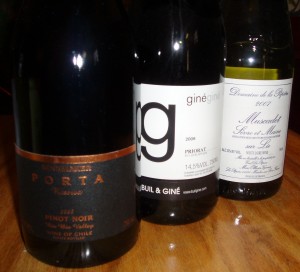 I can hardly believe it's already the second Monday in May - and time to unleash this month's Wicked Wines! These are some real treats to uncork through the ups and downs of the season change.
Buying Tip: If you can't find the specific wines I suggest in your home market, consider the varietals (or blends) I've chosen and enlist your local wine buyer to make comparable recommendations. These are some fun wines you won't want to miss!
I can hardly believe it's already the second Monday in May - and time to unleash this month's Wicked Wines! These are some real treats to uncork through the ups and downs of the season change.
Buying Tip: If you can't find the specific wines I suggest in your home market, consider the varietals (or blends) I've chosen and enlist your local wine buyer to make comparable recommendations. These are some fun wines you won't want to miss!
Viewing entries in
Spain
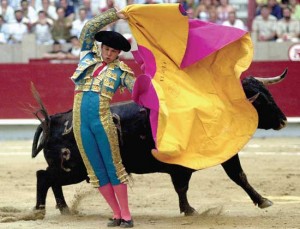 If you think of Spain's geography as the shape of a bull's head, you realize it doesn't have much of a western coast. Portugal actually comprises much of that area - with only the tippy-top of Spain's left "bull horn" having ocean boundaries. It is in this northwestern area, Galicia - and perhaps more notably, the D.O. Rias Biaxas (said Ree-as Byay-shas) - where arguably the most versatile white wine is created: Albarino.
With its northern location and proximity to the sea, it won't surprise you to learn Albarino has its work cut out for itself to avoid rot and ripen fully. (Or, well, maybe the high, spread out trellising by the vineyard managers has something to do with it, since the wind can more easily pass through the vines and help dry things out....) Whether natural selection is at play or not, Albarino fortunately has developed very thick skins - which impart the strong, beautifully floral aromas you should associate with this particular vino.
If you think of Spain's geography as the shape of a bull's head, you realize it doesn't have much of a western coast. Portugal actually comprises much of that area - with only the tippy-top of Spain's left "bull horn" having ocean boundaries. It is in this northwestern area, Galicia - and perhaps more notably, the D.O. Rias Biaxas (said Ree-as Byay-shas) - where arguably the most versatile white wine is created: Albarino.
With its northern location and proximity to the sea, it won't surprise you to learn Albarino has its work cut out for itself to avoid rot and ripen fully. (Or, well, maybe the high, spread out trellising by the vineyard managers has something to do with it, since the wind can more easily pass through the vines and help dry things out....) Whether natural selection is at play or not, Albarino fortunately has developed very thick skins - which impart the strong, beautifully floral aromas you should associate with this particular vino.
Actually, Albarino is often likened to two other grapes we've discussed now and again: Riesling and Viognier. It is associated with Riesling for its mineral characteristics and Viognier for the stone fruit and floral aromas that often float from the glass. It also has very low alcohol and high acidity. These factors make Albarino so versatile. (Low alcohol allows it to pair well with spicy dishes too, for example; the heat of the alcohol does not fuel the flames of spicy cuisine while the residual touch of glycerin adds a robustness that complements richer foods' texture. ) And it's not just that Albarino's innate characteristics make it a good match for these "trickier," spicy foods! The wine is also enhanced by the flavors found in these dishes: it tastes even more distinct than when it flies solo!
Albarino is a go-to wine for me particularly around holiday meals. It is so refreshing, has that extra bit of roundness to it texturally, complements so many dishes and is one even red wine drinkers can appreciate. With Easter a few weeks back, I brough home a bottle thinking I would save it for our feast. It never made it that far.... The Vinum Terrae's Agnus Dei Albarino offered such a lovely bouquet of peaches and apricots, it was love reignited. It delivered the same apricot-peachy goodness on the palate and was further enhanced by a serious squeeze of lemon citrus "juice" and a bit of wet-slate minerality. With its low alcohol, it quenched my thirst as I prepared the meal.
There are several Albarino's on the market, probably the most widely distributed being the Martin Codax. Have you enjoyed this varietal before? Which was the offering you tasted?
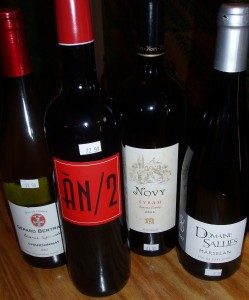 Of course we're all trying to forget about snow what with Spring springing. But I really think wine is like a snowflake. No two bottles (even of the same wine) are alike!
Wine is one of the few things constantly pushing me to explore something new - because I never know what amazing gem I might encounter once the bottle is uncorked.
Of course we're all trying to forget about snow what with Spring springing. But I really think wine is like a snowflake. No two bottles (even of the same wine) are alike!
Wine is one of the few things constantly pushing me to explore something new - because I never know what amazing gem I might encounter once the bottle is uncorked.
Today I am thrilled to debut a new series here at Pour Favor: Wicked Wines! Every second Monday of the month, pop on over to Wicked Local to see what treasures I've found - and hope you will also give a sniff, swirl and sip for yourself!
Are you familiar with any of the wines I feature this month? What's your April "Wicked Wine" find?
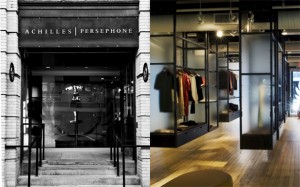 Ever been wary of a "Wines by the Glass" list? Been dubious the wines were opened two days prior to your debut at the bar? Or better yet, ever been overwhelmed by a list that's a real list, offering an ample array of wines you've never heard of? The bars/restaurants that take their glass pours seriously are a rare and wonderful breed. The trick is navigating their list with style and grace. Not always an easy task!
The Achilles Project/Persephone here in Beantown offers more than 20 different wines by the glass. To me, this is the first indicator they are serious about wine. The second indicator is that a good number of the wines on their list are "nerdy" (read: boutique offerings you don't see everyday). Like the boutique shop they run up front, they are focused on being fashion-forward, offering something new for folks to try. And because they are serious about glass pours, they also tend to be on the lookout for any wine that is past its prime, giving customers a greater opportunity to enjoy a "fresh" experience. Sign me up!
Ever been wary of a "Wines by the Glass" list? Been dubious the wines were opened two days prior to your debut at the bar? Or better yet, ever been overwhelmed by a list that's a real list, offering an ample array of wines you've never heard of? The bars/restaurants that take their glass pours seriously are a rare and wonderful breed. The trick is navigating their list with style and grace. Not always an easy task!
The Achilles Project/Persephone here in Beantown offers more than 20 different wines by the glass. To me, this is the first indicator they are serious about wine. The second indicator is that a good number of the wines on their list are "nerdy" (read: boutique offerings you don't see everyday). Like the boutique shop they run up front, they are focused on being fashion-forward, offering something new for folks to try. And because they are serious about glass pours, they also tend to be on the lookout for any wine that is past its prime, giving customers a greater opportunity to enjoy a "fresh" experience. Sign me up!
Today I thought it would be fun to go through their "Wine By The Glass" list and pick out a handful of grapes that might cause a customer or two to scratch their head - when really they should be doing a little jig and embracing the list's fabulous uniqueness. Buckle your seat belt!
Lambrusco: This red wine varietal from Emilia Romagna, Italy is something else... Lightly sparkling (frizzante, as the Italians like to say), this wine offers smart red berry fruit flavors, often with just a touch of sweetness eminating from the ripe grapes they pick for this elixir. Think antipasto or anything with a touch of saltiness or lightly fried (calamari anyone?) as a perfect pairing. Or sip it on it's own! It's a real charmer.
Assyrtiko/Asirtiko: This white grape varietal may have different spellings, but to me they say the same thing: crisp, citrus deliciousness. The closest "mainstream" varietal I can reference for new Assyritko drinkers would be Sauvignon Blanc. But Assyrtiko brings additional minerality and even a hint of smoke to the table. This is a probably one of the most well respected varietals in Greece, with its real home in Santorini. Unique, bright goodness in your glass.
Scheurebe: This is one of Germany's best known hybrid varietals, yet it is still somewhat of an orphan.... DNA tests prove that this grape's dad is Riesling, but Mom is still unknown (though previously thought to be Sylvaner). Gotta love a freak! This wine typically offers tremendous floral aromatics and a touch of residual sugar (RS). Tasting the wine out on the town can be a bit of a gamble, but your bartender should be able to guide you on just how sweet it is (though often enough you'll find they err on the drier side). Very much worth the experimentation, I've found. Often a great match for slightly spicy Asian dishes.
As for the Reds on their list, well.... some of these may be better paired with food than as a "cocktail wine" but it is certainly not everyday you see Austria's own delicious and lightly refreshing test-tube varietal Zweigelt on the roster, let alone a Mencia or a even a Monastrell (the Spanish name for the grape Mouvedre, which is better recognized in French wines). Nero d'Avola is up and coming, thought to be a pseudo Syrah with additional notes of currants, clove and vanilla; I find them more often distinct in their own right and offering far less oomph than Syrah can. But they are often just the thing to scratch the itch at a very reasonable price. Carignane can be wonderful, but I prefer to enjoy it when dinner's up, rather than at the bar with friends. I find it too dry, earthy and edgy without a bit of food on hand.
Any which way you look at it, the key thing is context. Do you want to sip something easy like a bit of Zweigelt while you chat with friends? Do you prefer something more familiar but still adventurous (like an Assyritko) to take the edge off a long day? Or do you crave a bit more body in your wine as you snack throughout the evening? If you're unsure you can either start with a bit of bubbly or white wine to get the ball rolling - and you can always ask your bartender for a recommendation to suit your mood!
Half the fun of wine is where you are, what you're doing or who you are with. It's worth a touch of experiment; don't you agree?
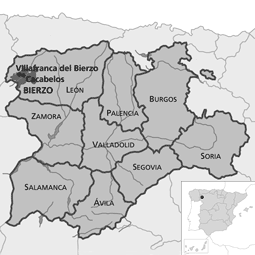 Were you nerdy about wine in 2006? If so, you probably read a few articles about Bierzo, or the indigenous grape varietal they cultivate there (Mencia). Maybe you even tasted it. (It was considered "up and coming" at the time - and perhaps it still is, though I've only ever tasted a handful of Bierzo/Mencia wines since.)
I became a fan of Mencia back then, having sampled a wine from Bierzo at my shop's annual Fall Grand Wine Tasting event. I ended up with half a case of Dominio de Tares Baltos. Since then I've fallen off the Bierzo wagon. I was simply ready for new adventures once I finished my 6 bottles.
Were you nerdy about wine in 2006? If so, you probably read a few articles about Bierzo, or the indigenous grape varietal they cultivate there (Mencia). Maybe you even tasted it. (It was considered "up and coming" at the time - and perhaps it still is, though I've only ever tasted a handful of Bierzo/Mencia wines since.)
I became a fan of Mencia back then, having sampled a wine from Bierzo at my shop's annual Fall Grand Wine Tasting event. I ended up with half a case of Dominio de Tares Baltos. Since then I've fallen off the Bierzo wagon. I was simply ready for new adventures once I finished my 6 bottles.
But as my co-worker and I continue to reevaluate and revisit the 1200 or so facings we have on our shelves, I found the Baltos again and decided to give it a whirl once more.
Bierzo is a fairly small wine-producing region located in the Northwest of Spain, quite close to Portugal. After the phylloxera epidemic killed most of the vines in the late 19th Century, economic crisis made it additionally difficult for Spanish winemaking to bounce back. But when they did in Bierzo, locals stayed true to their roots (no pun intended) and grafted Mencia vines, the dominant, native red grape varietal there. Bierzo became its own Denominacion de Origin in 1989. By then they were producing wines using more modern techniques to celebrate the best of their local varietals.
I have to admit, I was a bit disappointed when I retasted the Baltos. I was hoping for a wine with a bit of lift, as we like to say, something with red fruit flavors, a touch of earth and something... unique, I suppose. I remembered the Baltos as being distinctly versatile, pairing with a variety of foods and satisfying many people's taste buds. What I found was aromas of brett, or a barnyard essence with a touch more "funk" than simply walking into a real barn (a smell I actually cherish in a wine). Brett isn't a fault, per se (though it is controversial), but I was hoping for violets, black raspberries and sweet plums. The palate delivered a touch of black plum fruit, but its leather earthiness dominated. A gentle bite of licorice filled the back palette. The wine wasn't bad, but it wasn't doing it for me either.
Perhaps it was palette fatigue at the end of a long day tasting and evaluating 75 or so wines for the shop, but the bottom line is, I was underwhelmed.
As I discussed at the outset, Bierzo was considered an up-and-coming region just a few years ago. I write about this 'designation' often enough. The thing is, Mencia/Bierzo doesn't seem to have taken off - at least not here in Greater Boston. Frankly, I've tasted very little Mencia offerings. I'm not in a position to judge them as a whole one way or the other. But I am curious:
How many of you are familiar with the Mencia grape and what is your experience with these wines?
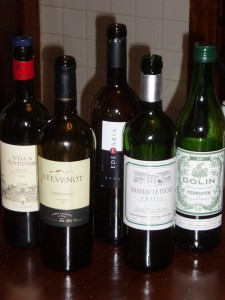 I hope you and yours had a wonderful time popping a cork or two last Saturday night for Open That Bottle Night. For my part, a handful of my closest friends descended on my place for a wonderful meal of braised paprika chicken, orzo and lemon-garlic asparagus.
We started with an appetizer of oysters, a small aperitif of exceptional Dolin Dry Vermouth and a glass of white Bordeaux ('06 Ch. le Tucau, Graves). Then with dinner we moved on to our "serious" wines - those we had been saving for whatever special occasion had yet to materialize. I wasn't exactly sure what my bottle of Spanish wine from Terra Alta, Spain would bring - but I had high hopes, too. This isn't a region you often see here in the States; my bottle was actually hand-carried back from Barcelona by my best friend after her wedding there.
I hope you and yours had a wonderful time popping a cork or two last Saturday night for Open That Bottle Night. For my part, a handful of my closest friends descended on my place for a wonderful meal of braised paprika chicken, orzo and lemon-garlic asparagus.
We started with an appetizer of oysters, a small aperitif of exceptional Dolin Dry Vermouth and a glass of white Bordeaux ('06 Ch. le Tucau, Graves). Then with dinner we moved on to our "serious" wines - those we had been saving for whatever special occasion had yet to materialize. I wasn't exactly sure what my bottle of Spanish wine from Terra Alta, Spain would bring - but I had high hopes, too. This isn't a region you often see here in the States; my bottle was actually hand-carried back from Barcelona by my best friend after her wedding there.
The Terra Alta D.O. boasts only 28 vineyards. The region is characterized by its Mediterranean & Continental climate (very cold winters, very hot summers), steep slopes and valley floors, and its proximity to its better known neighbor, Priorat. The cierzo breezes from the northeast do their part to keep the grapes dry, preventing rot. Terra Alta is considered an up and coming region, with many winemakers experimenting with better known grape varieties like Cabernet Sauvignon and Syrah, which have been permitted since 1995. More often you'll find native grapes Garnacha Tinta and Carinena as well as Garnacha Peluda and Morenillo, as far as the reds go.
Doing my best to navigate the Catalan description on the back of the bottle, I anticipated the Ede Aria 2003 would be a big boy, with need of decanting. The wine was a blend of three grapes: Garnacha Peluda (40%), Syrah (35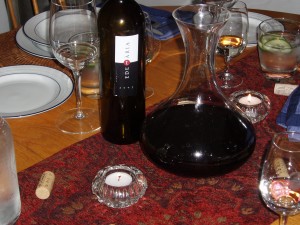 %) and Cabernet Sauvignon (25%). My inspiration for the paprika braised chicken was distinct from the wine I knew I would have on offer, so decanting was a priority to soften any rough edges and remove the sediment the wine was likely to throw. Since I know my friend prefers fruit-forward wines to uber-dry ones, I hoped this wine would deliver a nice silky mouthfeel, with both red and black fruits apparent. Finally, given the region's proximity to the Priorat, I hoped it would have a gentle herbaceousness and a touch of earthy leather. I was pleased to discover it delivered on all of the above!
%) and Cabernet Sauvignon (25%). My inspiration for the paprika braised chicken was distinct from the wine I knew I would have on offer, so decanting was a priority to soften any rough edges and remove the sediment the wine was likely to throw. Since I know my friend prefers fruit-forward wines to uber-dry ones, I hoped this wine would deliver a nice silky mouthfeel, with both red and black fruits apparent. Finally, given the region's proximity to the Priorat, I hoped it would have a gentle herbaceousness and a touch of earthy leather. I was pleased to discover it delivered on all of the above!
The other two wines we opened Saturday night were the 2004 Stevenot Tempranillo (Sierra Foothills, California) and the 2004 Villa Antinori Toscana (Tuscany, Italy).
Yes, Saturday evening I traveled the world with my friends! It was a pleasure to do so.
What wine(s) did you open for OTBN? Any highlights or disappointments in the mix?
 While I may talk a lot about my love of rustic, French wines, Spain is also near and dear to my heart. In particular, I frolic in the Priorat whenever I have the excuse to take home one of their higher ticket sensations. What is it I love about these wines? Let's see... how about:
Layered with flavor.
While I may talk a lot about my love of rustic, French wines, Spain is also near and dear to my heart. In particular, I frolic in the Priorat whenever I have the excuse to take home one of their higher ticket sensations. What is it I love about these wines? Let's see... how about:
Layered with flavor.
Concentrated with ripe dark and red fruit flavors.
Medium-plus bodied so as not to overwhelm and distract, and instead packing just enough of a mouthfilling punch.
Food friendly with solid acidity, but dry enough to warrant a bite or two of cured meat, manchego cheese or lamb. And to my taste, perhaps their best attribute:
Rustic, though in a distinct, clean, minerally sort of way (rather than having the damp-trodden forest floor or barn-tastic qualities of many Cote du Rhone wines).
The combination of seriously old vines (less fruit produced), super challenging growing conditions and the fact that the Priorat is the new 'hotness', means these wines fetch worthy, but not necessarily recession-sensitive prices.
Enter the Montsant region. Montsant is the lesser known horseshoe region that encompasses the Priorat. Here the climate is similarly arid, but the soil has its own unique mixture of slate, granite, sand, limestone and clay; each vineyard has a unique terroir. Like its better-known counterpart, Montsant also boasts a tremendous number of 100+ year old vines. (Yes, you can let out a cheer!) In fact, 55% of the vines in Montsant are >20 years old; Priorat can "only" boast 40%. And there you have it - tremendous concentration and distinct, let-your-heart-sing flavors! All that hard work by the vines to produce just a few clusters means happiness in your glass.
When its cold outside and dinner "in" with friends is on the menu Montsant wines are a brilliant option. I proved this little theory of mine last weekend when I hosted a bit of a dinner party. I was serving a spinach and beet salad with cashews and feta; garlic, lemon and thyme roast chicken; and roast potatoes. I wanted a wine with solid acidity, a bit of rusticity and great concentration. It also had to be light enough on its toes (that is, have enough bright fruit) to be universally appealing to my guests. I was tempted to go for a basic Cote du Rhone, but wanted riper, redder fruit flavors and something with a touch more minerality and less barnyard "funk". The steep-sloped Priorat region came to mind, but I knew I'd open several bottles and didn't want to spend $20 on each. A Montsant was a natural solution.
The Etim Seleccion 2006 is a new Montsant wine brought to us by the folks at Ole Imports. It has entered the market at a great time, too, just when we're looking for fabulous wines at accessible prices. The Etim is 60% Grenache, 30% Carigane, and 10% Syrah. This varietal combo means sweet, juicy, ripe, red fruits are delivered in a mouthfilling package; and the terroir in Montsant means you'll find a touch of clean, wet-slate minerality to boot.
Too much wine speak mid week? Let me put it this way: if you were going on a first date with the Etim, you'd be waiting for the moment when you could escort her out of the restaurant into the mind-clearing chill, gently push her up against the brick and discover for yourself just how succulent, sweet and edgy she is.
Can you beat that? What wine did you enjoy last weekend?
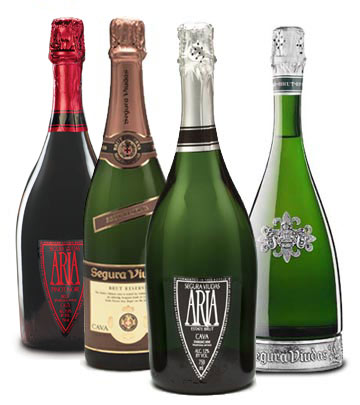 Ever heard of Cristalino? What about Freixenet? These are just two Spanish bubbly offerings on the market, known as Cava, that come in under $10 at your local shop. The thing about Cava is it's not just cheap - it's tasty, too!
Here are a few fun facts to get our conversation rolling today...
Ever heard of Cristalino? What about Freixenet? These are just two Spanish bubbly offerings on the market, known as Cava, that come in under $10 at your local shop. The thing about Cava is it's not just cheap - it's tasty, too!
Here are a few fun facts to get our conversation rolling today...
- Cava means cave, or cellar, in Catalan;
- More than 220 million bottles are sold each year;
- Four stars beneath the cork indicate it's D.O. authenticity;
- 95% of all Cava (and the best on offer) comes from Northern Spain's Penedes region;
- By law, any one (or blend) of five white grapes are permitted in Cava. The three most common are Macabeo, Parellada, and Xarello, with Chardonnay and Subrait (Malvasia) used on occasion.
- Less than 1% of all Cava is rose (in which case either Cabernet Sauvignon, Garnacha or Monastrell grapes are employed).
- And, the traditional method, or Methode Champenoise as we've already discussed, is used to create its lovely little bubbles!
Cava came into being in 1872 when Don Jose Raventos (head of bodega Codorniu) found himself tromping through Champagne, France and encountered their specialty for the first time. He was fascinated and became determined to produce a Spanish bubbly. But I find it delightfully refreshing Cava does not try to play second fiddle to its famous international counterpart. No, Sir!
For starters, the Penedes region is geographically and climatically very different than Champagne. They also use different grapes. Specifically, in Cava they use exclusively WHITE grapes, whereas in Champagne Pinot Noir is one of the 3 permitted varietals (and used often, at that). In Spain, the wine is aged for only 9 months on the lees (the dead yeast cells that give Champagne it's toasty character due to being aged on them for at least 15 months). The differences go on, but the important thing is the result: Cava is less nuanced, offering a simple, cheery, citrusy/fruity, high-acid alternative to Champagne.
For the record, while I have no problem popping a Cava cork for the sake of Cava drinking, I also have to say these wines really do work some additional magic when blended for your holiday brunch mimosa and the like. Their clean flavors (aka, fruity, lesser yeasty quality) don't compete with whatever other ingredients you're throwing together, instead adding a nice bit of lift to the festivities!
Of the three bubblies we've bantered about thus far, which is your preference? Champagne, Prosecco, or Cava?
 If you watched the final match of the 2008 Euro Cup (Spain won vs. Germany) and/or the phenomenal Wimbledon Men's Final where the Spaniard Rafael Nadal eventually won a nail biter against Roger Federer, then perhaps it is no surprise to you Spain is now also on course to "win" top seed as the world's largest wine producer. (In case you're wondering, yes, I already proclaimed "wine is a team sport". But I was getting more at sportsmanship, rather than the idea of winning or losing....). Back to the wine then, it seems beyond important things like heritage, culture, tradition, and number of suitable grape-growing acres, sound economics matter a heck of a lot, too.
What am I getting at? Well, apparently the French are drinking less domestically (French young'ns just aren't enjoying the stuff with as much vigor anymore, tisk, tisk!). But a big(ger) part of the challenge they face is actually a national, industry-wide failure to 'keep up' with market trends - and up and coming wine regions globally where wine is "better" packaged, cheaper and modernized (from techniques employed, to use of screw caps, etc.).
If you watched the final match of the 2008 Euro Cup (Spain won vs. Germany) and/or the phenomenal Wimbledon Men's Final where the Spaniard Rafael Nadal eventually won a nail biter against Roger Federer, then perhaps it is no surprise to you Spain is now also on course to "win" top seed as the world's largest wine producer. (In case you're wondering, yes, I already proclaimed "wine is a team sport". But I was getting more at sportsmanship, rather than the idea of winning or losing....). Back to the wine then, it seems beyond important things like heritage, culture, tradition, and number of suitable grape-growing acres, sound economics matter a heck of a lot, too.
What am I getting at? Well, apparently the French are drinking less domestically (French young'ns just aren't enjoying the stuff with as much vigor anymore, tisk, tisk!). But a big(ger) part of the challenge they face is actually a national, industry-wide failure to 'keep up' with market trends - and up and coming wine regions globally where wine is "better" packaged, cheaper and modernized (from techniques employed, to use of screw caps, etc.).
Unlike the sports pages these days, I haven't read one article yet where the Spanish are interviewed about this likely takeover in 2015. I wish I had found one. Those offering French perspectives indicate they are ready to fight the good fight and determined to make a comeback (before one is technically necessary in seven years time). They don't want to lose their crown, of course. And the scare is in them! They recognize they need to make a few adjustments to compete globally.
I don't pretend to know or even fully appreciate all of the nuances that have contributed to this pending "doom" for the French. (There's a great Time article from a few years ago I forgot about, which the folks at Vinography reminded me of when I was looking for a bit more perspective on the topic. It's worth the read if you have a few minutes over lunch today.) But I'm also convinced the French are the least likely in the wine-producing world to want to lose their earned status as quality producers just to edge out the Spanish on the Quantity Produced playing field. So I'm wondering how this is going to pan out.
What I do know is I want my French wines. I want them to be top quality. And I want to pay the price they're worth.
What's your take on all this?
Romance is half the fun in the world of wine. Every movie is chalk full of great imagery, enticing viewers to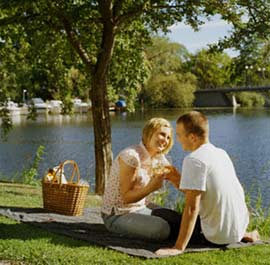 hit the riviera and sip a cool glass of rose, picnic on a hilltop overlooking the vineyard below, or dance around barefoot in a great big vat of grapes. Music and terroir are always part of the equation, too.
If you thought you couldn't live a romantic food/wine life in the Boston suburbs of Medford/Somerville, here's your chance to test the theory! This Saturday from noon to seven the Mystic River Music Festival will bring together all the necessary ingredients for a fabulous afternoon - and all the proceeds from your snacking and imbibing will go towards a great cause, the Mystic River Watershed Foundation.
hit the riviera and sip a cool glass of rose, picnic on a hilltop overlooking the vineyard below, or dance around barefoot in a great big vat of grapes. Music and terroir are always part of the equation, too.
If you thought you couldn't live a romantic food/wine life in the Boston suburbs of Medford/Somerville, here's your chance to test the theory! This Saturday from noon to seven the Mystic River Music Festival will bring together all the necessary ingredients for a fabulous afternoon - and all the proceeds from your snacking and imbibing will go towards a great cause, the Mystic River Watershed Foundation.
I spoke with Brian Lamb, full-time owner of Our Glass Wine Co. on Route 1 and part-time mastermind behind this great event. It seems that the Condon Shell (a Medford mini Hatch Shell venue, if you will) was the inspiration behind the event. A long-time lover of the site, Lamb approached Mayor McGlynn with the idea to use the Condon Shell for an afternoon of entertainment. McGlynn was more than happy to get on board. The Shell had been recently re-acquired by the city of Medford and McGlynn had hoped to bring music and the arts back to Medford. This was a perfect opportunity.
The event will feature music from local bands, grilled fare provided by Whole Foods, crafts by local artists, and other local vendors committed to all things Green. Perhaps most noteably (from my perspective), the wines on offer will all be organic selections.... and there are some TRULY phenomenal ones in the mix.
Here's a quick preview of just three of the many wines available on Saturday:
2007 Jelu Torrontes ~ Everyone knows Argentine Malbec. Well... Torrontes will have the same U.S. following as the leading white wine varietal coming from that part of the world soon enough! Not bitter at all (as some Torrontes can be) this wine is the PERFECT summer sipper. It offers gorgeous ripe fruits, healthy acidity and a nice medium body allowing it greater food pairing versatility. A welcome treat. The Cafe Europa team is responsible for bringing this little number to the event's wine roster.
2007 Mas de Gourgonnier Rose ~ If you've tasted the standard red Mas de Gourgonnier (in the crazy, 'fat' bottle with the long neck) you know you're in for a treat with this rose. This vineyard has been making organic wines before organic was "in". And this rose is one of the best out there. It offers fabulous summer strawberry and raspberry aromas and flavors, but is refreshingly crisp and dry (as all great rose should be). A blend of Grenache, Syrah, Mouvedre, Cinsault and Cab, it can hold up to serious BBQ magic, too. Ideal Wine Imports are responsible for bringing this to a store near you and will be donating this selection to the event.
2005 Vinos Pinol Sacra Natura ~ This is a red wine blend from the Terra Alta region of Spain (near Priorat, south of Barcelona) where the soil lacks optimal nutrients; this causes the vines to 'work harder' and results in fewer bunches but more concentrated fruit. The Sacra Natura in particular hails from a vineyard boasting 95 year old vines (read: even more concentrated fruit). A robust blend of Cariñena, Merlot, Cab Sauvignon, Syrah and Tempranillo, this wine does not hold back. Ole Imports & Ruby Wines will be donating this bad boy.
Rain or shine, the Condon Shell should be your local event stop this weekend!
So, what are you waiting for? Do you plan to be 'romanced' in Medford?

